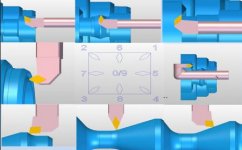I was running a lathe recently and ran into a problem setting a tool. Normally I've changed out boring bars and set the X and Z but never really have to mess with the R (radius) and T (tool position) values for cutter comps because the boring bars I run all face the same direction and we rarely change tool nose radi.
Long story short, I had to take a boring bar out and put in another one for an ID groove. The groove insert is a full radius insert .188" in width. I taught the tool in Z and X as I've done many times before with other tools, and I then changed the R value to .094, and the T value to 6 (It was 2 for our previous boring bar).
A previous tool did a face pass, backed up .100, and homed out before I changed this boring bar. I then went to run the groove tool and it came close to running into the part. The path it was going to take in X should have been exactly .100 above the face that was cut previously, and the value on the coordinate system said it was the same place in Z as was the other tool when it traveled that path backing away from the part. For some reason the bottom of the groove tool was about even with the face of the part.
Since the width is .188, half of which is .094 (almost the .100 gap that should have been there), the only thing I can think of is that when I changed the T value to 6 from 2, and the radius comp from .047 to .094, it must have factored in the center point of the width of the groove tool as being a compensated value for Z and didn't keep my initial Z value that I taught the tool at. That still doesn't make sense to be though because I've never had this problem with regular inserts like cnmg 432s which also have tool directions and radi.
Does anyone have any insight on what happened?
Long story short, I had to take a boring bar out and put in another one for an ID groove. The groove insert is a full radius insert .188" in width. I taught the tool in Z and X as I've done many times before with other tools, and I then changed the R value to .094, and the T value to 6 (It was 2 for our previous boring bar).
A previous tool did a face pass, backed up .100, and homed out before I changed this boring bar. I then went to run the groove tool and it came close to running into the part. The path it was going to take in X should have been exactly .100 above the face that was cut previously, and the value on the coordinate system said it was the same place in Z as was the other tool when it traveled that path backing away from the part. For some reason the bottom of the groove tool was about even with the face of the part.
Since the width is .188, half of which is .094 (almost the .100 gap that should have been there), the only thing I can think of is that when I changed the T value to 6 from 2, and the radius comp from .047 to .094, it must have factored in the center point of the width of the groove tool as being a compensated value for Z and didn't keep my initial Z value that I taught the tool at. That still doesn't make sense to be though because I've never had this problem with regular inserts like cnmg 432s which also have tool directions and radi.
Does anyone have any insight on what happened?







